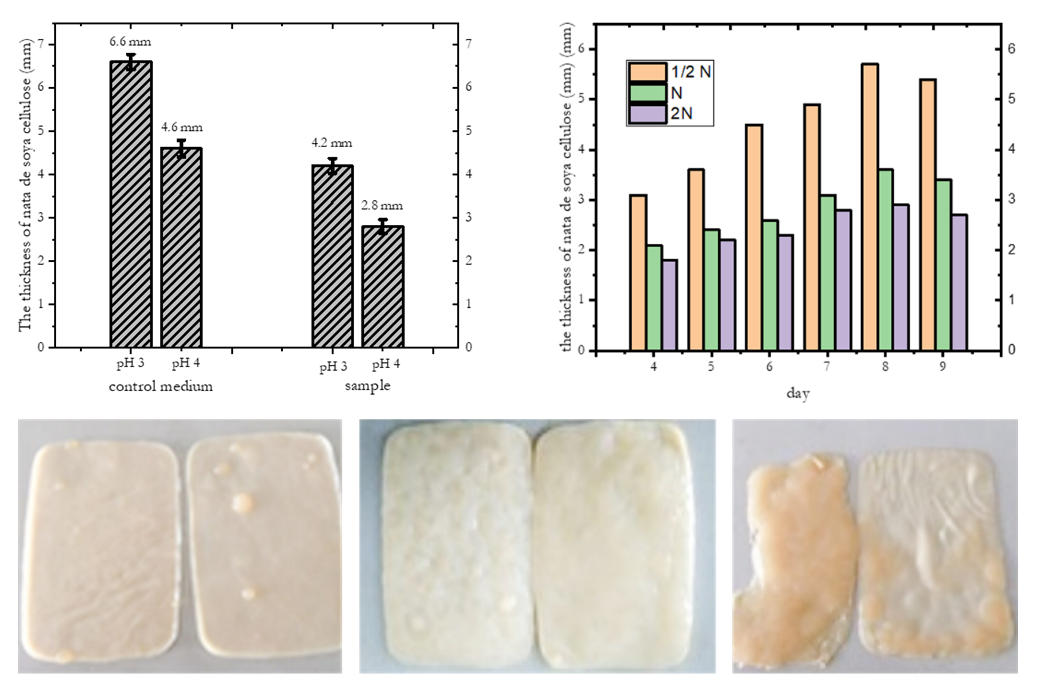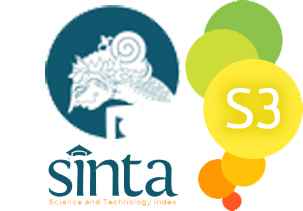The Utilization of Lamtoro leaves (Leucaena leucocephala L.) Extract as an Alternative Nitrogen Source on The Formation of Nata de Soya Cellulose from Tofu Whey Waste
Abstract
Nata is not only made from coconut water; it is also possible to produce it from other raw materials. In our study, nata de soya has successfully made using tofu whey as raw material. Research focused is on the utilization of lamtoro (Leucaena leucocephala L.) leaves as an alternative source of nitrogen in addition to the use of ammonium sulphate and urea which have generally been used in nata production. The selected research method was experimental. First, the Lamtoro leaves were mashed and then inserted into the medium and cooked until it boils. The medium was incubated at room temperature for 12-14 days and the thickness of the cellulose was then measured. The purpose of this study was to determine the effect of the using of lamtoro leaf extract (Leucaena leucocephala L.) as an alternative source of nitrogen for nata de soya cellulose formation. The optimization of pH and nitrogen contentration have been obyained. Three types of formula have been arranged, i.e. 1⁄2 of the control nitrogen concentration, equivalent, and 2 times of the control nitrogen concentration, to provide the variation concentration. Results found that the optimum pH was 3 and the optimum nitrogen concentration was ½ of the control nitrogen level. Nata de soya has then prepared using optimum condition of pH and nitrogen concentration. The maximum average of nata de soya thickness was 7.6 mm. In addition to leveraging the ability of medicinal plants and reducing the use of chemicals in the food processing, the use of alternate sources of nitrogen may also be adopted in the wider cellulose nata application.
References
Imam, P. 2007. Mengenal Lebih Dekat Leguminoseae. Kanisius, Yogyakarta.
Indrawati. 2019. Pemanfaatan pengolahan limbah cair dari industry tahu sebagai bahan dasar membuat nata de soya. J. Vokasi, 3(1), p.23-8.
Iryandi, F. A., Hendrawan, F., & Komar, N. 2014. Pengaruh Penambahan Air jeruk Nipis (Citrus aurantifolia) dan Lama Fermentasi Terhadap Karakteristik Nata de Soya, Jurnal Bioproses Komoditas Tropis, 1(1), p.8-15.
Ismawanti, I., Maswati, B., & Wahyu, R. 2013. Pengaruh penambahan ammonium sulfat terhadap kadar serat dan ketebalan pada nata de soya dari limbah cair tahu. J. Alkimia 1(1), p.1-12.
Miguel, G., Paul, G., & Dieter, K. 2013. Bacterial Nano Cellulose: A Sophisticated multifunctional material. E-book, CRC press, Taylor and Francais Group.
Muhammad, A., Sunarto & Wiryanto. 2015. Pemanfaatan limbah cair tahu menjadi nata de soya dengan menggunakan air rebusan kecambah kacang tanah dan bakteri Acetobacter xylinum. J. Ekosains, 7(1), p. 1-14.
Palimbungan, D., Robert, L. & Faizal, H. 2006. Pengaruh ekstrak daun lamtoro sebagai pupuk organic cair terhadap pertumbuhan dan produksi tanaman sawi, Jurnal Agrisistem, 2(2), p.96-101.
Retni, S., 2008. Pengaruh Konsentrasi Starter Acetobacter xylinum terhadap ketebalan dan rendemen selulosa nata de soya, Jurnal Fakultas Teknik Universitas Muhammadiyah Purwokerto. 1, p.19-24.
Saptarina, S. 2017. Pengaruh Variasi Konsentrasi Gula Jawa Terhadap Ketebalan, Warna, Aroma, Tekstur dan Rasa Nata de Tomato. Skripsi, Program Studi Pendidikan Biologi, Jurusan Pendidikan Matematika dan Ilmu Pengetahuan Alam. Fakultas Keguruan dan Ilmu Pendidikan, Universitas Sanata Dharma, Yogyakarta.
Siti, A., 2008. Pengaruh waktu penyimpanan bahan baku limbah cair tahu (whey tahu) terhadap pembentukan ketebalan selulosa nata de soya, Karya Tulis Ilmiah. STIKes Bakti Tunas Husada Tasikmalaya.
Sri, W. & Jumiati. 2019. Potensi Acetobacter xylinum dalam pembuatan nata de syzygium. J. Pend. Biologi, 6(2), p. 195-203.
Sulik, S., Wignyanto, and Sukardi. 2007. Pemanfaatan limbah cair (whey tahu) industry tahu menjadi nata de soya dan kecap berdasarkan perbandingan nilai ekonomis produksi. J.Tek. Pert., 4(1), p. 70-83.
Sutrisno, K. 2006. Isoflavon Senyawa multi-manfaat dalam kedelai, E-book pangan.com. p.1-7.
Syarifa, A., & Fatkhun, N. 2019. Penambahan ekstrak jeruk nipis dan konsentrasi inokulum terhadap karakteristik nata de soya dari limbah industry tahu Kabupaten Klaten. J. Kimia Riset, 4(2), p.133-42.
Wisnu, C. 2006. Kedelai khasiat & teknologi, Mughni Sejahtera, Bandung.
Yanti, N.A. 2017. Pengaruh penambahan gula dan nitrogen pada produksi nata de coco. J. Biowallacea, 4(1), p. 541-6.























